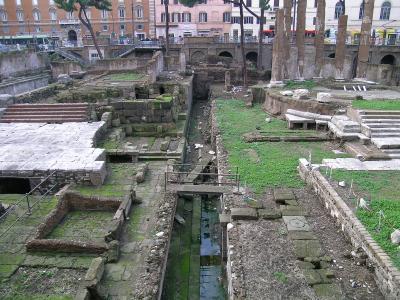Caesar's adopted son and successor, Augustus, ordered the structure created to protest the death of his father. The classical texts had stated Julius Caesar was stabbed in the Curia of Pompey on March 15th of the year 44 B.C. but it lacked material evidence.
Classical sources referred to the closure of the Curia, a place that would become a memorial of sorts, years after the assassination. Antonio Monterroso, CSIC researcher from the Institute of History of the Center for Humanities and Social Sciences, explains: "We know for sure that the place where Julius Caesar presided over that session of the Senate, and where he fell stabbed, was closed with a rectangular structure organized under four walls delimiting a Roman concrete filling. However, we don't know if this closure also involved that the building ceased to be totally accessible."

The complex in Torre Argentina (Rome), where Julius Caesar was stabbed. Credit: Antonio Monterroso/CSIC
In addition to the Curia of Pompey, researchers have started to study the remains of the Portico of the Hundred Columns (Hecatostylon). The two buildings are part of the monumental 54,000 square meter complex that Gnaeus Pompeius Magnus - Pompey the Great - who shared power in a triumverate with Caesar and Crassus, built in the capital to commemorate his military successes in the East around the year 55 B.C. Pompey was not shy about extolling his victories. Though Crassus defeated Spartacus to end Rome's Third Servile War, Pompey met some of the remnant army and defeated them and declared he put down the rebellion. But prior to that he had extended Rome's empire in Asia substantially.
While Caesar was off defeating the Celts, Pompey maneuvered for power and declared that Caesar could not stand for re-election in absentia, nor could he bring his army into Rome. Thus, Caesar 'crossing the Rubicon' entered the popular lexicon to mean taking an action from which there is no turning back. Caesar then showed Pompey who was the greatest Roman general. He fled to Egypt where the Egyptian king had him killed rather than enrage Caesar.
The concrete structure placed inside the Curia of Pompey to condemn his death was found by the researchers as part of a three-year project with the cooperation and support of Sovraintendenza ai Beni Culturali of Rome City Council, on the financial support of the Plan Nacional 2008-2011 of the Spanish Ministry of Economy and Competitiveness, and on the backing of the CSIC Spanish School of History and Archaeology in Rome.
Says Monterroso, "It is very attractive, in a civic and citizen sense, that thousands of people today take the bus and the tram right next to the place where Julius Caesar was stabbed 2056 years ago or even that they go to a theatre, since the main theatre of the capital is the Teatro Argentina, which is equally close."






Comments